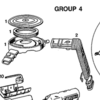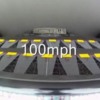Apples and Oranges
The videos indicate that the
difference in pressure between the engine compartment and the area immediately behind the vehicle is small enough that the a/c condensor fan can move air in either direction while the vehicle is moving. That's a cool bit of information, and yes it more or less resolves an old debate.
The videos do not indicate what the absolute pressure behind a moving Pantera is however. They neither prove or disprove my comment, that a negative air pressure zone exists behind a moving vehicle. Every blunt shaped vehicle and every vehicle with a Kamm-tail has an area of low pressure immediately behind it while the vehicle is moving.

Air in contact with the body of a vehicle creates drag in the form of friction which acts upon the vehicle as it moves through the air. A low pressure zone behind a vehicle also creates drag. A vehicle with a blunt shape creates a large area of low pressure behind it as it moves through the air. That low pressure adds significant drag to the vehicle, it slows the vehicle down. Paul Jaray developed streamlined car body work in the 1920s. His innovative body design featured a low-profile teardrop shape with a long tail to minimize the air resistance of passenger cars. The long tapering tail bent the air, it induced the air into following the gently tapering bodywork of the vehicle, thus preventing the formation of a negative pressure area behind the vehicle. But that long tapering tail had no practical use, it added to the length of the vehicle, it added to the weight of the vehicle and it added to the expense of building a vehicle.

Researchers working under the direction of Wunibald Kamm and building upon the work of others, developed a design principle known as the Kamm-effect, offering a more practical method for building an aerodynamically efficient body profile. (from the wiki)
"While the realities of fluid dynamics dictate that a teardrop shape is the ideal aerodynamic form, Kamm found that by cutting off / flattening the streamlined end of the tear at an intermediate point, and bringing that edge down towards the ground, he could gain most of the benefit of the teardrop shape without incurring such a large material, structural, and size problem. The airflow, once given the suggestion of the beginning of a turbulence-eliminating streamlined teardrop tail, tended to flow in an approximation of that manner regardless of the fact that the entire tail wasn't there ... According to the classic definition the tail should be cut off where it has tapered to approximately 50% of the car’s maximum cross section, which Kamm found represented a good compromise - by that point the turbulence typical of flat-back vehicles had been mostly eliminated at typical speeds." In other words, a Kamm tail minimizes the size of the low pressure area behind a vehicle moving through the air to the point that the drag on the vehicle created by the low pressure area approximates (doesn't equal) the drag that would have been created by the friction of the air moving over the tail itself.
The Kamm-tail or Kamm-back was first applied to automobiles in 1949, and didn't come into popular use until the 1960s. Its the fast back with a flat tail look that became so popular with sports cars and performance cars, including the Pantera. It is so common today that the design is taken for granted, nobody refers to it as a Kamm-tail any longer.
As a Kamm-tail car moves through the air it pushes the air out of its way, it slices through the air, and the wake in the air behind the vehicle will take the shape as though the vehicle had a long tapering tail, and in that area where the long tapeing tail would have been is a low pressure area instead. That is the low pressure I am referring to.
Aerodynamics ain't my baliwick boys, so I hope I've presented the information in an understandable way.
-G







